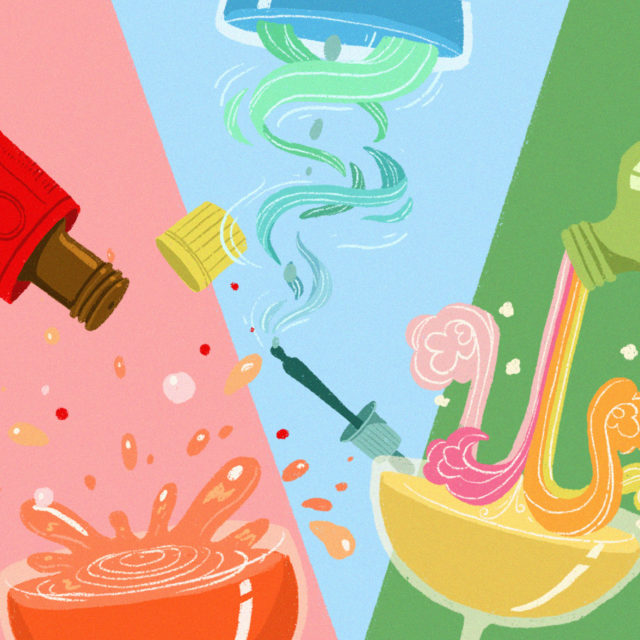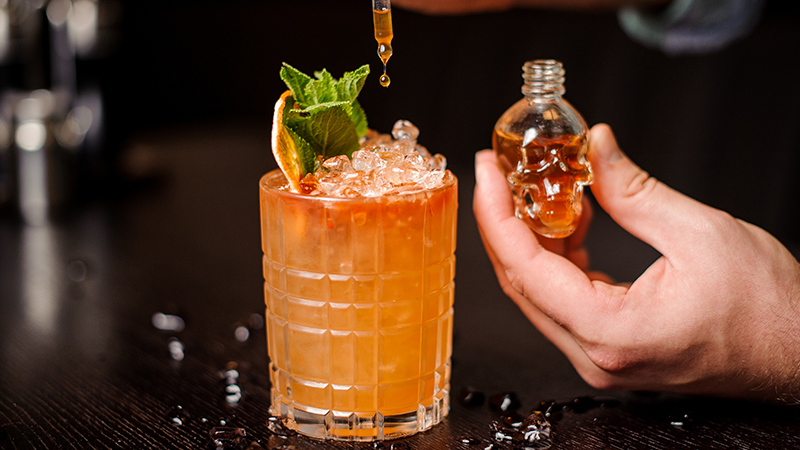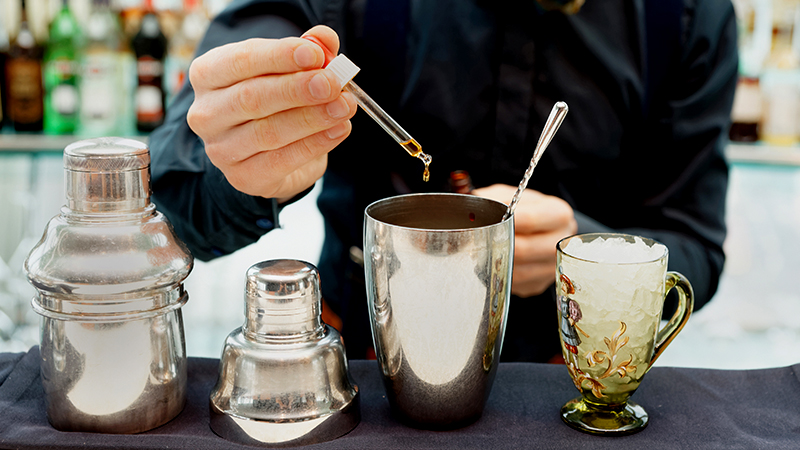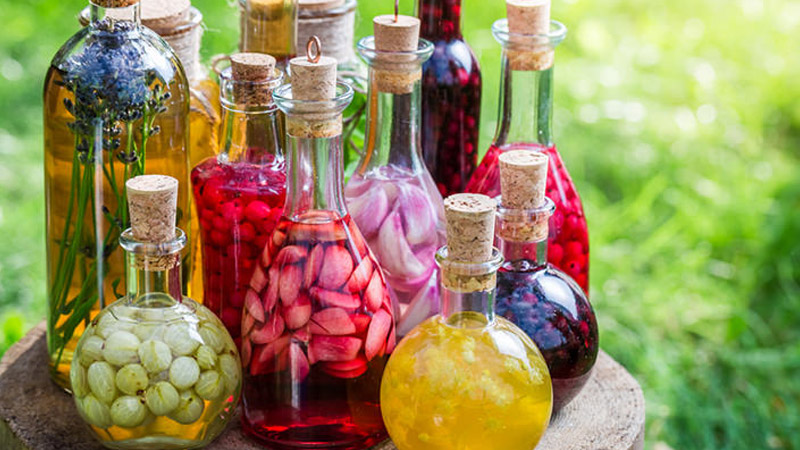Finishing touches define art. “A Day in the Life” loses masterwork status if the Beatles don’t add the song’s final lingering piano chord. Without the slightly mischievous upturn in her mouth, Mona Lisa is merely a pretty portrait. Hell, the room in “The Big Lebowski” isn’t tied together without the rug, per the Dude’s infinite wisdom. In the world of cocktails — mixologists’ own form of art —bitters, tinctures, and shrubs are a bartender’s version of these coups de grâce. The right number of drops, drips, or dashes from these power-packed elixirs elevates a libation from mundane to magic, leaving the imbiber little choice but to acknowledge the sublime craftsmanship in the glass.
The shared source of their sorcery is their intensity, which is why they’re typically doled out in teensy amounts. “All three are designed to be highly concentrated ingredients,” explains Gareth Moore, beverage director of Home & Away in San Diego. “Because of this, they can drastically change a drink’s flavor profile with just a few drops. Once you know how to use them, you can build a drink to a specific flavor profile efficiently.”
Originally, the trio’s shared purpose was intended to make those consuming them feel good in a whole different way. “I think it’s important to know that all three started out as medicines,” states Jamie White, co-owner and bartender at Pearl Diver in Nashville. “Even though they have these similar backgrounds historically, it’s important to understand they all have different profiles of ingredients and use.” The best way to get a handle on these differences is by looking at how they’re built. Bitters are made with a pure grain spirit inundated with bittering agents like fruit peels, spices, or funky stuff like bark or cassia. Tinctures act as straight-up botanical, fruit, or vegetable infusions without any bitterness. A shrub adds sugar to fruit juice and uses vinegar to cut the sweetness.
Many imbibers and bargoers these days have an awareness of how these ingredients are used, but this hasn’t always been the case. Those of us who muddled through the bad old days of the pre-2000 bar scene had a vague sense of Angostura bitters’ existence back then, but that was only because we had one friend smart enough to order an Old Fashioned while we did Kamikaze shots. Regardless, bitters were a misunderstood ingredient. Tinctures and shrubs, on the other hand, were fully unknown substances.
This changed with the craft cocktail movement’s nationwide explosion in the 2010s, when bartenders from Orlando to Omaha dug deep into drink history and resurrected their usage. This coincided with a bitters boom marked by several upstart companies experimenting with unique and funky flavor profiles. This one-two punch created a renaissance of cocktail enhancements, one that fully blossoms when you look at each ingredient separately.
Bitters
Cocktail bitters (as opposed to digestive bitters like Amaro Montenegro or Fernet Branca, which are their own beasts) are highly concentrated concoctions designed to add flavor depth and balance to a cocktail. They can also occasionally act as a drink salvager, even for the professionals. “They’re sometimes used as a savior to fix a cocktail that I didn’t nail the first go-round,” White says. “It’s one of the reasons why they usually come in at the end of a drink for me.”
Angostura, Peychaud’s, and orange bitters are the holy trinity of bitters, and they’re essential if you’re making classics like Old Fashioneds or Sazeracs. But they can (and should) lay the groundwork for the kind of alchemy that leads the home bartender to more advanced voodoo.
“Don’t be afraid to experiment!” says Ashlyn Miyasaki, bar manager at Bar Henry in Los Angeles. “Next time you make Moscow Mules at home, try adding a couple dashes of Angostura bitters and see what you notice. Add orange bitters to your Martini. Try different brands of orange bitters and use them in tandem. Once you’ve got a feel for it, then you can branch out to different drinks and unique bitters.”
You can even go beyond the recommended two dashes of bitters — if you dare. Bartenders love the Trinidad Sour, a delicious yet brazen concoction that calls for a whopping 1.5 ounces of Angostura. It tastes like how prog metal sounds: bold, burly, and relentlessly complex.
Making Your Own Bitters
Making bitters is fun, and is easier than you might think. Here’s a recipe to get you going:
What You’ll Need:
- 16 ounces Everclear
- 4 teaspoons of botanicals, preferably four different botanicals
- Four 4-ounce Mason jars
In each jar, add 4 ounces of Everclear and one teaspoon of a botanical. Label each jar with the botanical used, and seal. Let botanicals steep for about two weeks, shaking the jars daily and tasting them regularly. Strain out the matter with a coffee filter. Dilute with water or sweetener if desired. Mix the contents of each jar.
NOTE: Common botanicals used in bitters include juniper berries, cardamom, ginger, cloves, caraway, rose hips, and fennel. Your neighborhood spice shop should have ample supply. When you get the hang of it, you can also throw in flowers, legumes, or dried fruits to achieve extra funky goodness.
Tinctures
Tinctures are the metronomes of the bartending world, a steadying beat that bartenders break out to achieve singular flavor precision. “I use tinctures when a drink calls for something super specific, like black pepper,” White explains. “I can make a black pepper tincture and use a drop of it in a drink instead of trying to use a pinch of pepper. The drop of a tincture will always be more consistent.”
This sense of control can make it an ideal homemade ingredient if you fret about getting the drink’s flavor just so. And they will be homemade — the only tinctures you’ll find on the market are for medicinal use or are made from cannabis (which has its own medicinal purposes). But that’s no big deal. All you need to make a tincture is alcohol, the agent providing the infusion, and the patience for the infusion to do its thing. There’s no limit to what the infusing agent may be; people use everything from fruit and veggies, to herbs and flowers, so wander around your garden and see what looks delicious.
Making Your Own Tinctures
If you’re new to making tinctures, keep things simple. Here’s how:
What You’ll Need:
- 4 ounces high-proof vodka (at least 100 proof)
- Infusion agent, such as fruit (for this example, use one a whole mango)
- 1 Mason jar
Place the mango in the jar. Pour in the vodka and seal. Put in the refrigerator for about a week, stirring and tasting each day.
NOTES: Using a higher-proof spirit could expedite things. If using berries as the infusion agent, fill the jar halfway with berries.
Once you get the hang of the process, though, you can push the boundaries of creativity a bit. This recipe from Gareth Moore is a great place to start:
Cinnamon Bourbon Tincture (Courtesy Gareth Moore)
What You’ll Need:
- 1 part cinnamon bark
- 4 parts high-proof bourbon (at least 100 proof: the stronger the proof, the better)
- 1 Mason jar
Fill a jar with the cinnamon bark. Pour in the bourbon and let sit in the refrigerator for one week. Strain out the cinnamon bark and transfer to a dropper bottle.
Shrubs
Because vinegar is involved, shrubs offer a little more food and drink-based versatility than bitters or tinctures. “Shrubs can make a nice base for vinaigrette salad dressings,” Miyasaki says. In a cocktail, shrubs’ mélange of vinegar, fruit, and sugar creates a bright, bold complexity that adds sweet, tangy, and tart notes, making it a favorite ingredient for bartenders when they’re behind the stick. “I prefer working with shrubs at my bar, but that’s because I know I’m going to be making a large volume of drinks every night,” says Moore.
Indeed, there is a bit of a conundrum with making shrubs at home. They don’t have the staying power of bitters and tinctures, which can both keep their integrity for about a year on a home bartender’s shelf. Shrubs are also designed for shelf life, but last half that long and will lose their mojo quicker the more they’re used. This doesn’t mean you shouldn’t make shrubs at home — you should, because they’re delicious. Besides, the vinegar makes shrubs a killer fruit preserver — a property that made them a hit back in the American colonial era. If given the choice between turning a past-its-prime peach into a superb cocktail ingredient or chucking it into your garbage in a few days, there’s only one good answer.
Making Your Own Shrubs
There’s a little more prep work involved when making shrubs compared to tinctures and bitters, but they’re still relatively easy to make. Besides, every shrub you create gives fruit a second life. Here are a couple of recipes to get you started:
Strawberry Basil Shrub (Courtesy Ashlyn Miyasaki)
What You’ll Need:
- 4 cups ripe strawberries, hulled and halved
- 1 cup fresh basil leaves
- 4 cups sugar
- 1 teaspoon kosher salt
- 1 tablespoon balsamic vinegar
- 4 cups white wine vinegar
Place the strawberry halves and basil leaves in a large bowl. Add sugar and salt, then cover. Let set at room temperature, stirring occasionally, until liquid begins to form. Add vinegar, and stir until sugar is dissolved. Fine strain the liquid, and store in the refrigerator.
Grilled Peach Shrub (Courtesy Jamie White)
What You’ll Need:
- 1 peach, sliced and pitted
- 1 cup sugar
- ½ cup apple cider vinegar
- ½ cup regular vinegar
Grill peach slices until they have slight char marks. Mix all ingredients in a pot. Cook on low for 15 minutes or until sugar dissolves. Blend ingredients with a hand blender. Put back in the pot, and let simmer for five to 10 minutes. Strain and refrigerate.



